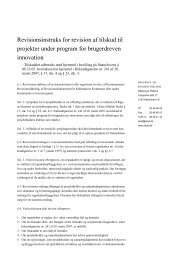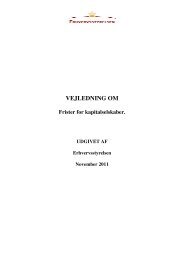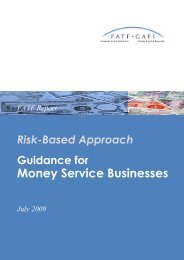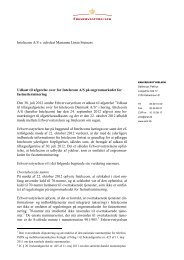Competing in the Single Market - SMEs and ... - Erhvervsstyrelsen
Competing in the Single Market - SMEs and ... - Erhvervsstyrelsen
Competing in the Single Market - SMEs and ... - Erhvervsstyrelsen
Create successful ePaper yourself
Turn your PDF publications into a flip-book with our unique Google optimized e-Paper software.
The Role of <strong>SMEs</strong> <strong>in</strong> Transitional Economies<strong>SMEs</strong> <strong>in</strong> <strong>the</strong> B4<strong>SMEs</strong> play an important role <strong>in</strong> <strong>the</strong> economy <strong>in</strong> general, but <strong>the</strong>ir role is particularly prom<strong>in</strong>ent<strong>in</strong> <strong>the</strong> economic transformation of countries <strong>in</strong> transition (CITs). Some of <strong>the</strong> most significantbuild<strong>in</strong>g blocks for economic stability <strong>and</strong> growth <strong>in</strong> CITs are <strong>the</strong> creation of <strong>the</strong> private sector, <strong>the</strong>development of entrepreneurship <strong>and</strong> <strong>the</strong> creation of <strong>SMEs</strong>. <strong>SMEs</strong> stimulate private ownership <strong>and</strong>serve as <strong>the</strong> ma<strong>in</strong> ‘learn<strong>in</strong>g ground’ for managerial <strong>and</strong> entrepreneurial skills; <strong>the</strong>y are flexible <strong>and</strong>can adapt quickly to chang<strong>in</strong>g market dem<strong>and</strong> <strong>and</strong> supply situations; <strong>the</strong>y generate employment,help diversify economic activity <strong>and</strong> make significant contributions to exports <strong>and</strong> trade (UNECE2003).“The Small <strong>and</strong> Medium Enterprise (SME) sector carries great hopes <strong>and</strong> great burdens <strong>in</strong> <strong>the</strong>evolution of all of <strong>the</strong> transitional economies. It is difficult to imag<strong>in</strong>e ei<strong>the</strong>r ris<strong>in</strong>g overall liv<strong>in</strong>gst<strong>and</strong>ards or social peace without susta<strong>in</strong>ed <strong>and</strong> healthy growth of this sector.”(McIntyre (2002), p.2)The CITs (or new market economies) have all undergone very rapid <strong>and</strong> transformational reformsover <strong>the</strong> last 15 years. These countries have managed cont<strong>in</strong>uous growth <strong>in</strong> GDP <strong>and</strong> foreign<strong>in</strong>vestment <strong>and</strong> decreased rates of <strong>in</strong>flation <strong>and</strong> unemployment while undergo<strong>in</strong>g massive economic(e.g. privatization) <strong>and</strong> political changes (see chapter one of this report). One commonality of <strong>the</strong>secountries’ reform agendas was <strong>the</strong>ir focus on develop<strong>in</strong>g <strong>the</strong> small <strong>and</strong> medium enterprise sector.In <strong>the</strong> early stages of transition, one of <strong>the</strong> ma<strong>in</strong> catalysts of transformation was <strong>the</strong> re-structur<strong>in</strong>gof <strong>the</strong> large, orig<strong>in</strong>ally state-owned enterprises, generally with high levels of foreign <strong>in</strong>volvement,ei<strong>the</strong>r through direct ownership, jo<strong>in</strong>t ventures or foreign know-how (Scase (2000), p.iv). Althoughto vary<strong>in</strong>g degrees, overall, <strong>in</strong> <strong>the</strong> past decade, <strong>the</strong> transition economies have become <strong>in</strong>creas<strong>in</strong>glydependent on large foreign-owned corporations for exports, bus<strong>in</strong>ess R&D, product, process <strong>and</strong>organizational <strong>in</strong>novation, capital <strong>in</strong>vestments, job creation, <strong>and</strong> economic growth.As transition has progressed, however, <strong>the</strong> importance of small <strong>and</strong> medium enterprises (<strong>SMEs</strong>) as<strong>in</strong>struments <strong>and</strong> vehicles of economic renewal <strong>and</strong> vitality has <strong>in</strong>creased. S<strong>in</strong>ce <strong>the</strong> early 1990s, <strong>the</strong>B4, as well as many o<strong>the</strong>r C<strong>and</strong>idate Countries, have experienced dramatic <strong>in</strong>creases <strong>in</strong> <strong>the</strong> shareof both employment <strong>and</strong> GDP accounted for by <strong>SMEs</strong> (World Bank 2002). Generally, it is fair tosay that <strong>SMEs</strong> play a key role not only <strong>in</strong> <strong>the</strong> social but also <strong>in</strong> <strong>the</strong> economic fabric of <strong>the</strong> transitioncountries (European Commission (2002e <strong>and</strong> 2003j), McIntyre (2002 <strong>and</strong> 2003)).The ris<strong>in</strong>g importance of <strong>SMEs</strong> is partially due to <strong>the</strong> shift of production from formerly state-ownedenterprises, many of which were dismantled <strong>in</strong> <strong>the</strong> 1990s (European Commission 2002e). In <strong>the</strong>early stages, many <strong>SMEs</strong> <strong>in</strong> <strong>the</strong> transition economies were created from <strong>the</strong> break-up of large, stateownedenterprises <strong>and</strong> mass privatization, while o<strong>the</strong>rs were conversions from <strong>the</strong> unofficial sector.The rapid rise <strong>in</strong> <strong>the</strong> economic significance of <strong>SMEs</strong> <strong>the</strong>refore “does not <strong>in</strong> itself po<strong>in</strong>t at a healthydevelopment of <strong>the</strong> SME-sector” (ibid.). The crucial question concerns what conditions <strong>and</strong> measuresare needed to build an environment that is conducive to <strong>the</strong> development of dynamic, competitive,<strong>and</strong> <strong>in</strong>novative <strong>SMEs</strong>.35
















